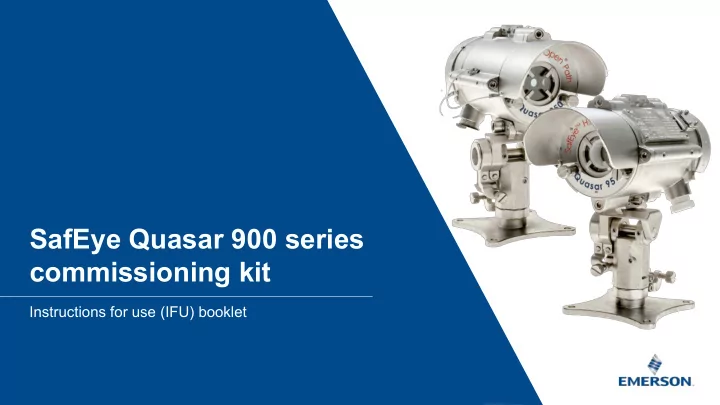

SafEye Quasar 900 series commissioning kit Instructions for use (IFU) booklet
Commissioning Kit There are 3 commissioning kit options: • 888247-1 for methane calibration • 888247-2 for propane calibration • 888247-3 for ethylene calibration The commissioning/alignment kit unit (P/N 888247) is required for commissioning and future maintenance checks. Only 1 kit is required per site. Emerson Confidential
The commissioning kit includes: • Telescope Kit - to make sure the source and detector are aligned (P/N 888210) • Function Check Filters - P/N 888260-1÷6 • Magnetic mode selector - to select the detector operating mode (P/N 790285) • 2 functional check filters (P/N 888260-1÷6) for system installation and periodical functional testing • Two hex keys - one for connecting the unit to the tilt mount, and the other for tightening the alignment screws. Emerson Confidential 3
The Quasar 900 can be installed and maintained by a single person Emerson Confidential
Maintenance The Quasar 900 does not require calibration and needs minimal maintenance during its long-life time. Maintenance includes window cleaning and functional testing using a test filter. Emerson Confidential 5
Alignment telescope With the use of only an alignment telescope, magnetic mode selector and function test filters, the 900 series can be installed and commissioned in a matter of minutes. Emerson Confidential 6
Magnetic mode selector Emerson Confidential 7
Function test filters Emerson Confidential 8
The installation process consists of 4 easy steps: Emerson Confidential 9
Step 1: Positioning Before positioning the source and detector on the tilt mount, two elements need to be verified: First ensure a clear line of sight between the source and detector. We offer different source models to support coverage of wide variety of ranges. Measure the distance between the source and detector installation points and verify that it fits the range of the source model you have. Also, make sure the points chosen for connecting the open path gas detection system are stable. Place the source on the tilt mount and verify the 2 pins are well in place. Tighten the screws with the hex key. Follow the same steps for the detector as well. When done, make sure that the installation is firm and not vibrating or loose. Emerson Confidential 10
Step 2: Alignment - Crude In this step the alignment telescope will be used to perform a fine alignment of the source and detector. The first step of the alignment process is to remove the front shield by using the two captive screws. Make sure the source and telescope contact surface is clean. Place the telescope in front of the source and make sure that the two pins on the front of the source are positioned to fit the holes on the telescope. Then fasten the telescope with fastening screws, starting with the upper screw followed by the 2 side screws. Loosen the 2 horizontal alignment screws and the 2 vertical alignment screws to get free range of movement. Then roughly align the source towards the detector. Now tighten the horizontal crude alignment screw and the vertical crude alignment screw. Emerson Confidential 11
Step 2: Alignment - Fine To achieve fine alignment we'll start with the vertical fine alignment screws. Turn the 2 fine alignment screws simultaneously in opposite directions until bringing the scope to the center of the detector then tighten the fine alignment vertical screw. Follow the same steps with the horizontal fine alignment screws. Turn the 2 fine alignment, screws simultaneously in opposite directions until bringing the scope to the center of the detector and tighten the fine alignment horizontal screw. Remove the telescope. Reinstall the front shield and tighten the 2 screws. Follow the exact same steps for the detector as well. Emerson Confidential 12
Step 2: Alignment - Zero calibration Zero calibration must be done whenever there is a new installation, change in installation, optical alignment and after window cleaning. Before "zero calibration" make sure that the path is clear between detector and source, there are clear weather conditions and that there is no gas present in the path. To 'zero calibrate' the system swap the magnetic mode selector 3 times on the receiver side until you get the yellow led stable. The 0-20 mA output should now be at 1mA. Wait 1 minute until the led returns to blinking green. Now the system is Zero Calibrate. Emerson Confidential 13
Zero calibration - HART An additional approach to perform 'zero calibration' is to use the HART diagnostic unit for easier installation and maintenance. Begin with connecting the HART handheld unit to the intrinsically safe connector on the side of the detector. After communication is established, go to the maintenance screen and press the 'calibration' button 3 times and wait until the detector returns to normal working mode. Emerson Confidential 14
Step 3: Verification On the HART maintenance screen, you should verify that the signals are within the specified range per the signal values table as listed in the manual. The signal verification check corroborates the current signals from the flash source compared to that of previous alignments. This check should be performed every 6–12 months. The signal should be checked according to threshold levels. Emerson Confidential 15
Step 4: Validation The last step is to check the system functionality by using the functional check filters and the HART handheld unit. Position the functional check filter in front of the detector. The filter must be centered over the detector's viewing window. Wait for 20 seconds and read the LEL value on the HART’s maintenance screen and verify that a blinking red warning status appears on the receiver’s back side. Repeat this step with 'alarm' functional check filter and verify that a solid red alarm status appears on the receiver's back side. Emerson Confidential 16
Keep an eye on your safety Emerson Confidential 17
Recommend
More recommend